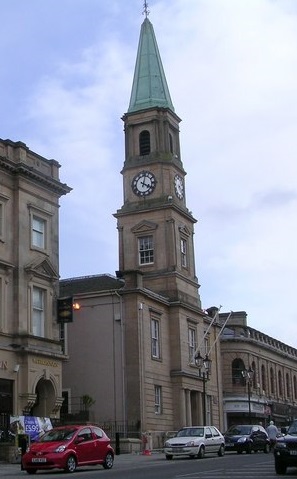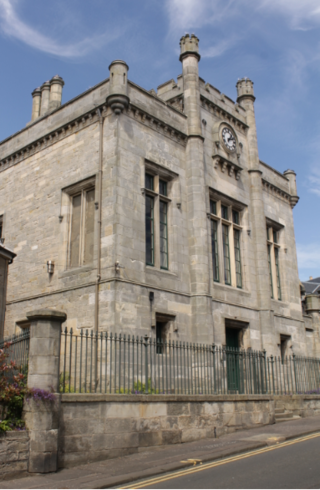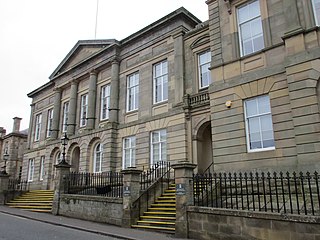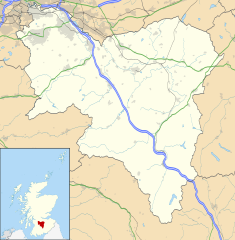
Glasgow City Council is the local government authority for Glasgow City council area, Scotland. In its modern form it was created in 1996. Glasgow was formerly governed by a corporation, also known as the town council, from the granting of its first burgh charter in the 1170s until 1975. From 1975 until 1996 the city was governed by City of Glasgow District Council, a lower-tier authority within the Strathclyde region.

Lanark is a town in South Lanarkshire, Scotland, located 20 kilometres to the south-east of Hamilton. The town lies on the River Clyde, at its confluence with Mouse Water. In 2016, the town had a population of 9,050.

Hamilton Townhouse is a building in Cadzow Street in Hamilton, South Lanarkshire, Scotland, which is operated by South Lanarkshire Council. It contains both the town's main public hall and public library, as well as various council departments including licensing and community learning. It is a Category B listed building.

The Chambers Institution is a municipal structure in the High Street in Peebles, Scotland. The structure, which was designed to accommodate a library, a museum, an art gallery and Peebles Burgh Hall, is a Category A listed building.

A tolbooth or town house was the main municipal building of a Scottish burgh, from medieval times until the 19th century. The tolbooth usually provided a council meeting chamber, a court house and a jail. The tolbooth was one of three essential features in a Scottish burgh, along with the mercat cross and the kirk (church).

Dumbarton Burgh Hall is a municipal structure in Church Street, Dumbarton, West Dunbartonshire, Scotland. The building, which is the headquarters of West Dunbartonshire Council, is Category A listed.

Dunoon Burgh Hall is a municipal structure in Argyll Street, Dunoon, Scotland. The structure, which is used as an events venue, is a Category B listed building.

Airdie Town House is a municipal building in Bank Street, Airdrie, North Lanarkshire, Scotland. The town house, which was the headquarters of Airdrie Burgh Council, is a Category B listed building.

Stirling Tolbooth is a municipal building in Broad Street, Stirling, Scotland. The structure, which was the original meeting place of Stirling Burgh Council, is a Category A listed building.

Rothesay Town Hall and County Buildings is a former municipal building in Castle Street, Rothesay, Scotland. The structure, which was the meeting place of Rothesay Burgh Council and of Bute County Council, is a Category B listed building.

The Glasgow Tolbooth was a municipal structure at Glasgow Cross, Glasgow, Scotland. The main block, which was the meeting place of the Royal Burgh of Glasgow, was demolished in 1921 leaving only the steeple standing. The steeple is a Category A listed building.

Cupar Burgh Chambers is a municipal structure in St Catherine Street in Cupar, Fife, Scotland. The building, which was the meeting place of Cupar Burgh Council, is a Category B listed building.

The Old Sheriff Court is a former municipal and judicial building in Wilson Street, Glasgow, Scotland. The building, which is home to the Scottish Youth Theatre, is a Category B listed building.

The Justiciary Buildings is a judicial complex in the Saltmarket in Glasgow, Scotland. The complex, which operates in conjunction with similar facilities in Edinburgh and Aberdeen, is dedicated for the use of the High Court of Justiciary, which is the supreme criminal court in Scotland. It is a Category A listed building.

West Wemyss Tolbooth is a municipal building in Main Street, West Wemyss, Fife, Scotland. The structure, which is used as commercial offices, is a Category B listed building.

Tain Tolbooth is a municipal building in the High Street, Tain, Highland, Scotland. The structure, which is used as a courthouse, is a Category A listed building.

Kinghorn Town Hall is a municipal building in St Leonard's Place, Kinghorn, Fife, Scotland. The structure, which is used as holiday accommodation for tourists, is a Category B listed building.

Burntisland Burgh Chambers is a municipal structure in the High Street, Burntisland, Fife, Scotland. The building, which is the meeting place of the Burntisland Community Council, is a Category B listed building.

Hamilton Sheriff Court is a judicial building in Almada Street, Hamilton, South Lanarkshire, Scotland. The building, which continues to serve as the local courthouse, is a Category A listed building.

Lanark Sheriff Court is a judicial building in Hope Street, Lanark, South Lanarkshire, Scotland. The building, which continues to serve as the local courthouse, is a Category B listed building.





















